Motorcycle Investor mag
Subscribe to our free email news

Commando Cult
(by Guy ‘Guido’ Allen, Apr 2021)
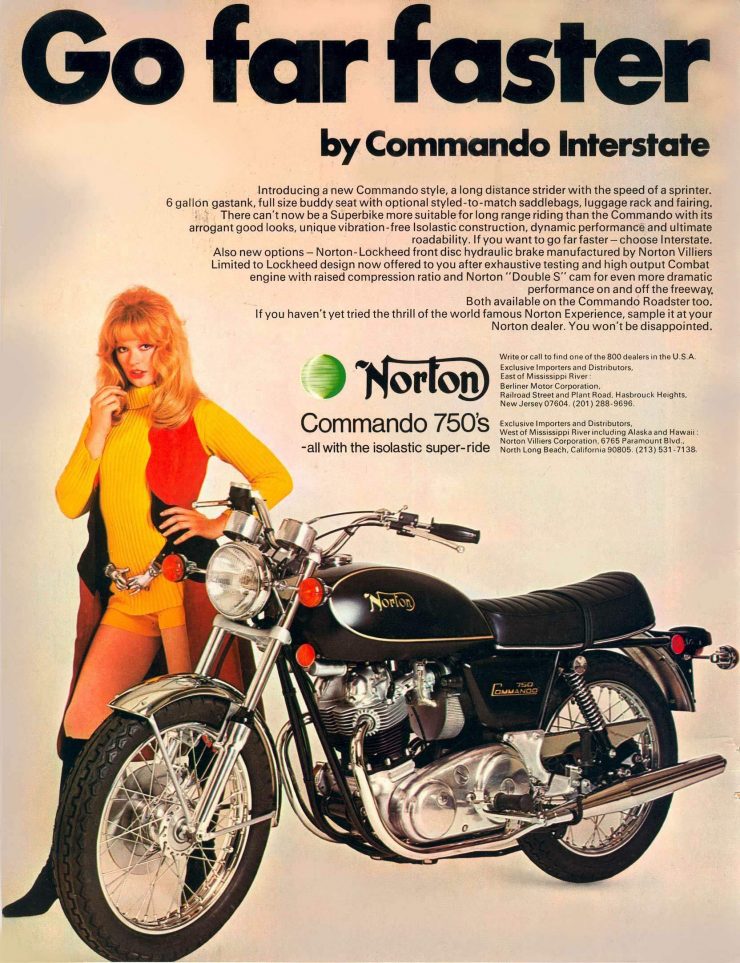
Model profile: Norton Commando
How the Brit twin became a cult classic
All these decades down the track – more than five – it’s incredible that a relatively narrow focus and low-volume motorcycle can still hold so much cultural traction. We’re talking of the Norton Commando. (And by that I mean the originals and not the revival models.)
First shown at the UK Earls Court Show (then enjoying the sunset of its glory as the motorcycle expo to watch) in 1967, the Commando was built in something resembling volume from February 1968 to - several changes of ownership and factory later - October 1977.
For those not in the know, we're talking of a 750-850cc air-cooled, pushrod, four-stroke twin, claiming 65 horses in Combat form (58-60 in the cooking versions) and weighing in the region of 190kg. Nothing special by current standards, perhaps, but definitely not out of the performance goalposts.
So why did it etch itself into the local riding psyche? There's plenty of theories out there, one of which is it was the world's first street-legal superbike worthy of the name. Which is tripe. Owners of HRD/Vincents, which predate the Commando by a fair margin, have reason to take issue with that, for a start.
I have another, if less sexy and more complex, theory. First, Norton had (like Triumph) successfully spent decades etching its name in the UK-centric racing landscape and established itself as a romantic name. Second, the company had the good fortune to produce its best model ever at about the time when the western-world's motorcycle market was expanding at a phenomenal rate.
Early baby-boomers were getting into it, and the late baby-boomers are now joining them in the retro rush, once again pushing up their value as classics. And despite the current price rises, they're cheaper than the super-desirable stuff (again, Vincent), easier to ride, and much more comfortable than other twins of the same era.

HISTORY
Okay, let's go back a step and see where the monster came
from. Norton's history can be traced to the late 19th
century, but it's the pre-WWII racing record on the
348-633cc singles that really made the marque's name. A
who's who of racing of the time (Woods, Frith, Hunt,
Walker) rode them and established the brand as one to beat
across Europe.
Post-war, things were tougher, but the record was still stunning with singles such as the 498cc Manx being the mainstay. Racing names such as Duke, Minter, Hailwood and Surtees added to the trophy cabinet. Though it irks me to say it, the win on Sunday sell on Monday philosophy has a proud history.
Herbert "Bert" Hopwood (who joined Norton in 1946) is a name you'll come across several times if you read the history of assorted English marques, and seems to be the father of the Commando twin. His influence came to bear with the design of a 497cc overhead valve twin, which hit the road in 1948 in Dominator guise. It was redeveloped many times, with surprisingly few cosmetic changes, and eventually grew to 828cc (badged as an 850 for the last Commandos).
It's the late 1960s, WWII finished barely two decades ago (which means the middle aged-men running the company probably had some involvement) and you're looking for a tough and sexy name for your new, big, streetbike. What was the toughest, meanest, outfit of the war (assuming you only want to talk about the winning side...)? Commandos. Gee, now there's a cheeky name for a motorcycle.
The kids who buy it missed The Big One, but their dads might approve - who couldn't like something named after war heroes? Oh okay, their mums. Even better! Well, that's one guess on the thinking of the time.
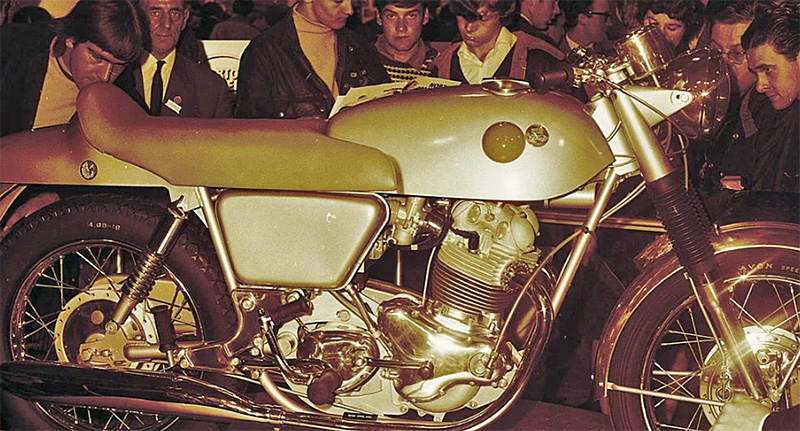
In late 1967 Norton rolled its prototype Commando onto the Earls Court stand. It was silver, with an orange seat, and some weird green globular thing on the fuel tank that (according to reports of the time) was meant to represent the new corporate identity. They ditched the last bit, and the orange seat. (The pic above shows the first Earls Court show bike, while below is a slightly later variant – note the different tank badging – shown in Stockholm.)
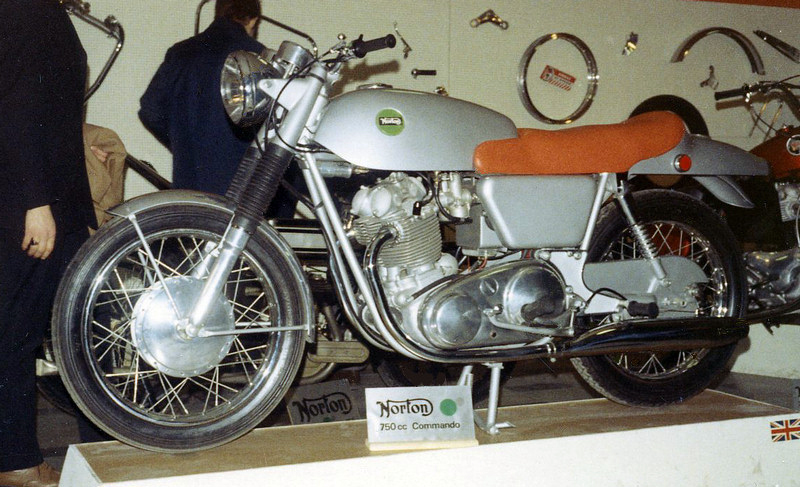
The 1968 production model (green bodywork, black frame and seat) ran a version of the existing 750 Atlas engine, but ditched Norton's previous premium frame - the McCandless Featherbead - in favour of a new item that included isolastic engine mounts. And this was the crux of the new model.
Both Triumph and Norton vertical twins (and later Yamahas, and others) became vibration factories in their own right as they grew from 500cc to 650, then 750. The stroke of brilliance in Norton's case was to isolate the engine vibrations by mounting the powerplant in flexible mounts (something which owners of some recent H-D models will be familiar with), hanging from what was then a massive two-and-a-quarter-inch top tube. Bernard Hooper and Bob Trigg were credited with the design. (We're told Trigg later moved to H-D.)
In original form, you got a drum brake at both ends, a rear cowl (then called the Fastback, or ducktail in modern parlance), plus the new frame and a variation on the familiar Atlas powerplant.
There are numerous variations on the Commando theme. For
example, between the first bike and the 1972 Fastback Mk
IV, there was an S, a Roadster, a MkIII SS, Interstate, an
SS street scrambler to appease an American market that
still wasn't appeased... it goes on. And there were a
couple of Hi-Rider variations.
Fastbacks continued to 1973, 750 Combats had been around a while by then and are described by one history as "an unfortunate episode", while 850s had been in production for some time and took over the flag until the demise of the Hopwood twins.
Old colleague and friend Rob Smith, who has owned four,
once mentioned over coffee that most of the disc brake
models ran the stopper on the right but, for no apparent
reason, there was a batch that ran them on the left. Call
it a practical joke from the shop floor.
A good resource for trying to make sense of all the
variations is the UK owner site at noc.co.uk,
which has some well-sorted historical information.
If you were cashed up, you could buy a new Norton over the
last couple of decades. The alternatives included building
one from the complete list of spares available in the UK -
there are people who will do this for you - or the modern
952 then 961 remake of the machine by Kenny Dreer at
Norton America.
Dreer ran out of funding and the torch was picked up by UK businessman Stuart Garner and his company Norton Racing, with a 961 designed by Simon Skinner. That exercise ended in a financial fiasco. Of course the story isn’t over, as the brand is being revived again in the UK with what looks like proper funding, via the India-based TVS Motor.

RIDING IT
Without doubt the Commando's distinguishing feature, that
isolastic frame, is what makes it work. A decent
four-stroke 750/850 twin is almost guaranteed to provide
reasonable grunt, but having the vibration isolated (in a
pre-balance shaft engine) makes it an unusually
pleasurable experience.
The rest comes down to simple maths. It's small, slim, has enough power to make life interesting - how hard can it be?
Those in the know prefer the drum brake models, which often stop better than those using the Lockheed discs. A 1972 example I rode some years ago, owned by journalist David Morley, got around this by ditching the original front disc and caliper in favour of a single Fireblade set-up. It was a good idea and looked surprisingly unobtrusive.
Whether it's a good ride often comes down to the individual motorcycle, its set-up, plus the rider's preferences. They can have sweet engine and gearbox, while the suspension tends to be adequate but relatively primitive by current standards.
Overall, a realtively compact bike with around 60 horses makes for an interesting package. We're talking about a motorcycle that will easily exceed the old 100mph benchmark.
Something the Commandos had was an enviable reputation for good handling when set up properly. This was the case even with the last of the breed. In comparison tests between final-generation Triumph T160s and Norton Commandos (so we're talking 1975 or there-abouts) the Norton usually won when it came to performance on a sports road. Interestingly, the four-speed transmission (compared to five for the Triumph) was sometimes seen as an advantage in this environment.
I own both a 1975 T160 and Commando (a Mark III Roadster) and prefer the Triumph as a sports package – but that could be ascribed to individual riding tastes.
Parts are readily available, not all that expensive, and there's a lot of service knowledge out there. Owners say you can make it a reliable classic – which is code for don't even consider it as a day-to-day mount. But a well set-up one can be a trustworthy Sunday bike.
Well set-up is the catch, though. It seems to be the fate of Commando owners is to spend the first few months of ownership tinkering and sorting.
As classic folk attached to any marque will tell you, this is a state-of-mind thing. If you want those cussed pre-wrapped features like hands-off reliability, look elsewhere. If a bit of a riding and mechanical challenge is you, you've come to the right place.
As compensation, what the Commando does offer is living legend status and a thoroughly interesting ride.
***
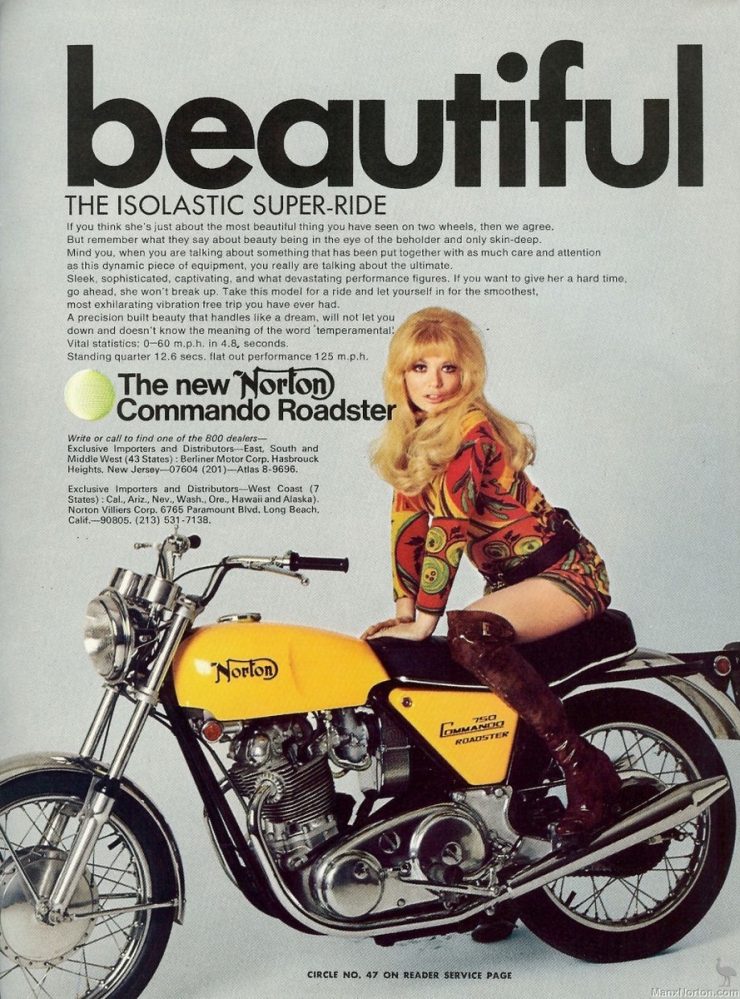
WHAT MODS?
How far you modify your Norton may well depend on how deep
your wallet is. However there are some fairly
common/popular mods which can aid reliability and/or
reduce maintenance. Here are some of the
better-established ones.
Bottom end: Combat engines in particular were notorious for eating main bearings, though all models may do it eventually. Without going into details, Superblend bearings have long been seen as the fix, though expert fitting is critical.
Isolastic mounts: They do flog out eventually and the later MkIII vernier versions (versus shim) are a worthwhile fit.
Carburetion: Open for debate. Standard twin Amals work fine, though there are aftermarket Keihin set-ups available which claim more horses and more reliable starting. Some folk advise retro-fitting a single Amal Mk II concentric on the basis it's easier to tune, or a Mikuni.
Ignition: Bin the points and go for a Tri-Spark or Boyer electronic set-up, if you want to go the low-maintenance route.
Fuel tank: If by some miracle you have a surviving fibreglass tank, store it and replace - it's a fire hazard.
Front brake: Drums are okay while the stock Lockheeds on disc models are like most discs from the era, which means ordinary in the dry and worse in the wet. Some owners swap them over for later model discs and keep the originals for future restorers.
Riding position: It can feel a bit like you’re sitting on a fence railing. Flat bars and rear-sets are a popular change-over, assuming you can cope with the more sporty ride position and the extra weight on the wrists.
Front tyre: Typically Commandos have 4.10 width rubber at both ends – essentially the same set-up as on the equivalent NVT stablemate, the Triumph T160. You can sharpen up the front significantly by reducing the width to 3.60. This works for the T160 as well.
Electric start: If it’s still healthy, well done. The
original kit really wasn’t up to the job, however there
are two things you can do to extend its life considerably.
They are, fit a good-sized lithium battery as the instant
grunt makes the starter’s job a whole lot easier; And get
in the habit of kicking over the engine, effectively
priming it, a couple of times before going for the
electric button. Freeing it up first will do wonders. In
the long run, you may well need to fit an upgrade kit,
which is readily available.
SPECS
Good
Recognised
classic
Good
handling for period
Good
parts & support
Not
so
good
Reliability
is an issue
SPECS
Norton
Commando 850 MkIII 1975-77
ENGINE
TYPE:
air-cooled,
two-valves-per-cylinder, pushrod parallel twin
CAPACITY:
829cc
BORE
&
STROKE: 77 x 89mm
COMPRESSION
RATIO:
8.5:1
FUEL
SYSTEM:
twin 30mm Amal carburettors
TRANSMISSION
TYPE:
Four-speed, constant-mesh
CLUTCH:
Metal diaphragm
FINAL DRIVE: Chain
CHASSIS
&
RUNNING GEAR
FRAME
TYPE:
Steel twin-loop, isolastic engine mounts
FRONT
SUSPENSION:
Telescopic Roadholder forks
REAR
SUSPENSION:
Twin Girling shocks
FRONT
BRAKE:
single fixed disc, single caliper
REAR BRAKE: single fixed disc, single caliper
DIMENSIONS
&
CAPACITIES
WET
WEIGHT:
233kg
SEAT
HEIGHT:
795mm
WHEELBASE:
1450mm
FUEL
CAPACITY:
19lt Interstate, 13.6lt Roadster
TYRES
FRONT:
4.10 x 19
REAR:
4.10 x 19
PERFORMANCE
POWER:
45kW (60hp) @ 6200rpm
TORQUE:
75Nm @ 5000rpm
OTHER
STUFF
PRICE
WHEN NEW @ Au$2000
***
RESOURCES
Classic Two
Wheels 1973 Commando 850 review
Classic Two Wheels 1975 Commando 850 MkII Roadster review

See the story on our 850 Commando here
-------------------------------------------------
Produced by AllMoto abn 61 400 694 722
Privacy: we do not collect cookies or any other data.
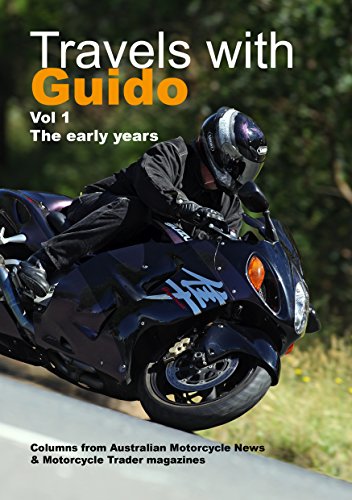
Archives
Contact





